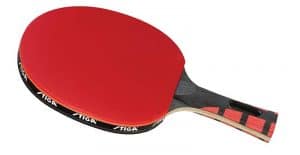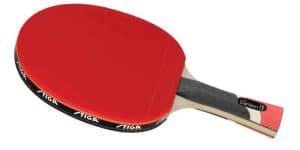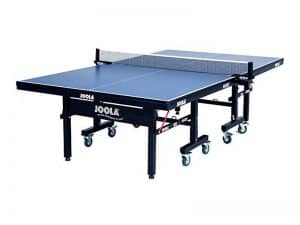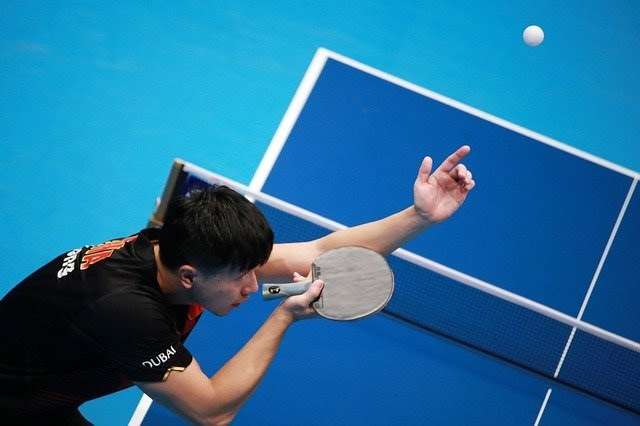Paddle Tennis vs Pickleball vs Padel (Differences Explained)
- Alex Horscroft
- Last updated
Sure, tennis is fun. But we’ve all played plenty of tennis in our time. Time to try something new! How about pickleball or paddle tennis? But wait… what’s the difference between pickleball and paddle tennis? I was asking myself that too!
But don’t you worry, I’ve spent some time researching to save you the trouble!
In this post, I dive into paddle tennis vs pickleball vs padel. My goal is to inform you exactly what the differences are between these three similar sports so you can pick the one that you most like the sound of.
Table of Contents
What Is Paddle Tennis?
Paddle tennis (sometimes known as paddle ball) dates all the way back to 1915, making it the oldest of the three sports. Despite its age, it’s not all that popular, and you might struggle to find information about it online. The sport rebranded to POP Tennis in 2015, and this seems to have increased its exposure a great deal.
You play the sport on similar court materials to tennis, and the size is a little short of two-thirds the size of tennis courts at 50 ft x 20 ft for classic courts. However, some tennis courts already have markings for paddle tennis. These courts are much bigger at 60 ft x 27 ft.
Paddle tennis includes both singles and double play, and both versions are played on the same court; there are no markings unique to either. That being said, doubles is far more popular than singles. In singles, you can’t volley until the fourth ball, but in doubles, you can volley the ball straight after serving.
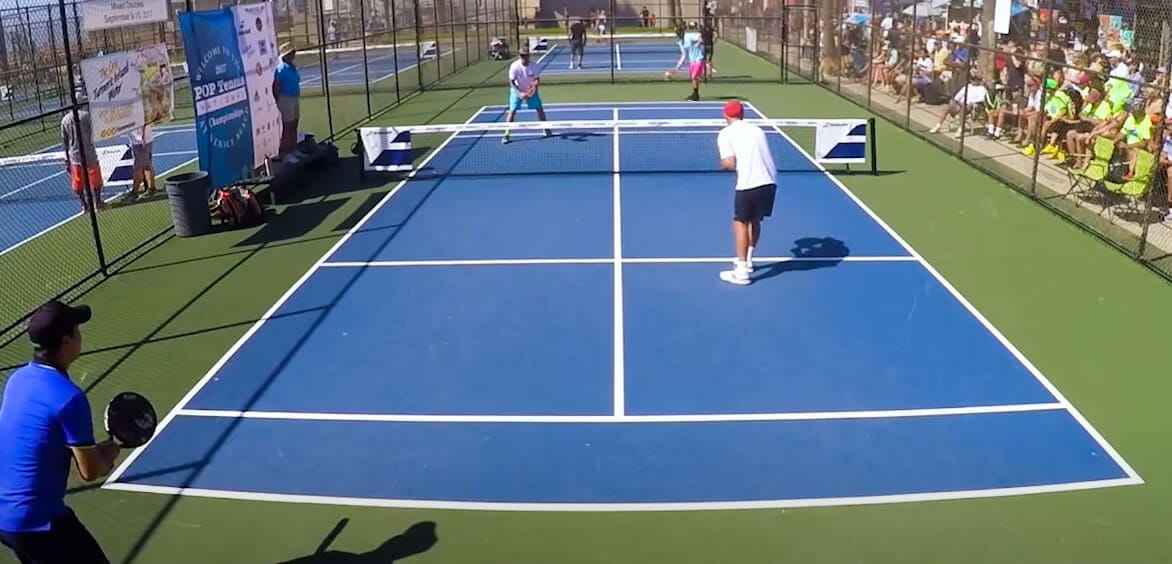
Screenshot from USPTA YouTube video
Serving
You must perform all serves underarm and strike the ball at or below the net’s height. You can either play the ball straight out of your hand or bounce it behind the baseline before striking it. However, when you pick one of these methods, you must stick with it for the remainder of the set.
What’s more, you only get one serve. There are no second serves in paddle tennis!
Equipment
Paddle tennis rackets are rigid and perforated. They are also much thicker than regular tennis rackets. At the bottom, they have a strap allowing you securely attach them to your wrist.
As for POP Tennis balls, they are like regular tennis balls but have reduced pressure. Green dot balls are the official ball. They contain 75% of the pressure relative to tennis balls. Orange dot balls are the other kind. They instead contain 50% relative pressure and are aimed at children.
Scoring
Scoring is identical to tennis, following the 0, 15, 30, 40, game system. Like tennis, sets are also first to 6 games, tiebreakers decide sets, and the first to 2 sets wins.
What Is Pickleball?
Pickleball is often compared as a blend of three top racket sports: tennis, badminton, and table tennis. Created in 1965, pickleball is played on the same size courts as badminton, and you can play indoors or outdoors. Although the court is much smaller than tennis, it is very hard to cover it yourself playing singles. As such, players almost exclusively play doubles.
What’s unique about pickleball is the kitchen and double bounce rule. The kitchen is an area adjacent to the net where all volleying is illegal. This prevents players from being able to perform easy smashes.
As for the double bounce rule, each team must allow the ball to bounce once following a serve. This means the earliest stroke eligible for a volley is the fourth hit.
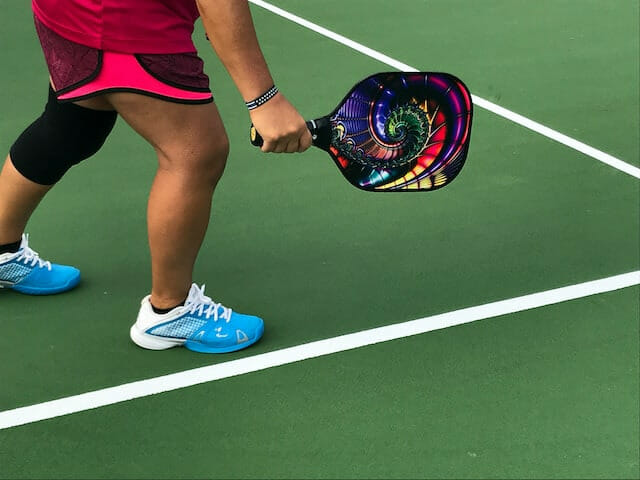
Serving
You must perform all serves underarm and below waist level. The motion must also be upward, with the top of the paddle below your wrist. No second serves.
Equipment
Even though the rules for pickleball rackets are not all that different from paddle tennis and padel, the rackets have a very different appearance.
Part of this is due to one distinction in the rules: the paddles must not have holes. Pickleball rackets also have much thinner racket faces.
As for pickleball balls, they have holes in them! They are also made of rigid plastic, not rubber, so striking them produces a loud sound.
Scoring
You play games up to 11, like table tennis, and you need 2 points of clearance to win a game.
However, you can’t claim a point from any old rally, you have to be serving This means pickleball games last much longer than you likely expect!
Read More: Pickleball vs Tennis
What Is Padel?
Padel was invented in Mexico in 1969 and is the most popular of the three sports. It’s much like a mix between tennis and squash.
You play games on an enclosed court similar to squash with glass walls and wire fences. A net runs through the middle of the court, and the size of said court is around 30% smaller than a tennis court. Like, pickleball, padel is almost entirely a doubles game.
The ball can only bounce once, like most racket sports, and you are free to use the walls to make returns. You can either let the ball hit the wall before striking it or even hit it into your own wall to make a return. This is as long as it lands on your opponent’s side before hitting one of their walls. You’re also allowed to volley at any time, assuming you are not receiving a serve.
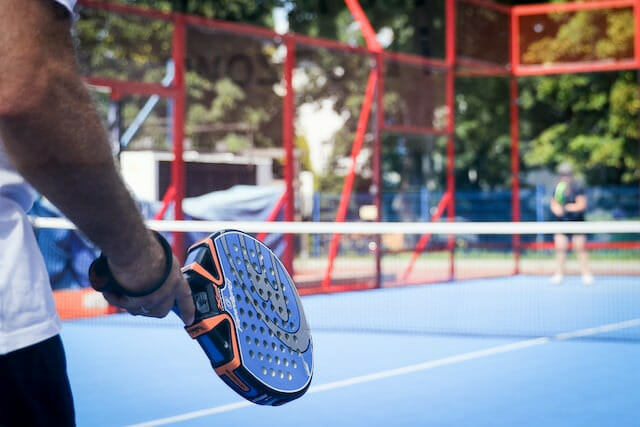
Serving
You must execute all serves underarm. To perform a serve, drop the ball behind the baseline and strike it at or below waist level. Note that the ball doesn’t just have to land cross-court into the opponent’s service box. It also has to not bounce into the wire fence on the sides of the court.
Second serves are permitted, allowing you to try and serve a little aggressively.
Equipment
Padel uses perforated rackets with a foam core, and the balls are similar to tennis but have less pressure.
Scoring
Padel shares the same scoring as tennis and paddle tennis.
Paddle Tennis vs Pickleball vs Padel: Similarities
There are multiple similarities between these sports. It’s probably why people so often ask, ‘is pickleball the same as paddle tennis?’.
Anywho, let’s start out with a padel vs paddle tennis similarity — they use the same scoring systems. The way you score these games is identical to tennis, so you should be able to jump right in.
The rackets for both sports are also the same. Having looked at the official racket requirements from each governing body, there is massive overlap, so it’s unsurprising to see both sports use the same perforated rackets with foam cores.
Switching things up, we have a key similarity between pickleball and paddle tennis. Both use the double-bounce rule. This requires teams to allow the ball to bounce once for two strokes following the return of serve. Consequently, the fourth stroke in a rally is the earliest you can volley the ball. However, this only applies to singles in paddle tennis. For doubles, you can volley immediately after serving.
Similarities between all three sports are much fewer. The main similarity, I would say, is that all three sports are primarily designed for doubles play (although some people play singles for paddle tennis). Furthermore, you have to serve underarm for all three sports.
Paddle Tennis vs Pickleball vs Padel: Differences
If you’ve watched a game of each of these sports, you could easily mistake one for the other, especially paddle tennis and pickleball. However, each game is easy to identify if you know what to look for.
One way to quickly recognize padel is the court. Pickleball vs paddle tennis courts are similar, but padel is easy to spot as you play it in an indoor glass enclosure. The gameplay is also rather different, as players will use the side and back walls to create awkward angles to help them win points.
Pickleball is easy to recognize by knowing the difference between paddle tennis rackets vs pickleball rackets. While pickleball rackets are similarly sized to paddle tennis rackets, they are a rounded rectangular shape rather than an oval. Their paddles vs pickleball are also much thinner and come with wrist straps.
Another key difference between paddle ball and pickleball is that pickleball balls are hard, not soft, and have holes in them. You will also notice they produce a loud cracking sound when struck — very different from the sound produced using the softer balls in paddle tennis and padel.
Leading on from this, one more difference in paddleball vs pickleball is the ball color. In paddleball, they essentially use reduced-pressure tennis balls with either green or orange dots on them. Pickleball, on the other hand, uses balls of uniform color. They are usually yellow, but other vibrant colors are common as well.
Paddle tennis is perhaps the hardest to identify of the three sports as it has fewer unique qualities. However, by recognizing the unique qualities of the other sports, such as padel’s glass enclosure court, it’s easy to spot paddle tennis by means of process of elimination.
That being said, there are two unique qualities of paddle tennis. The first is the court size as it differs from both other sports. However, as a spectator, you can’t exactly go and measure a court! Instead, pay attention to serving. In paddle tennis, you can both play a serve out of your hands and drop serve like in pickleball. However, unlike pickleball, once you serve a certain way, you can’t switch until the set has concluded.
| Paddle Tennis | Pickleball | Padel | |
| Created | 1915 | 1965 | 1969 |
| Min points per game | 4 | 11 | 4 |
| Singles/doubles | Mostly doubles | Doubles | Doubles |
| Court size | 20 ft x 50 ft or 27 ft x 60 ft | 20 x 44 ft | 32 ft 10 in x 65 ft 7 in |
| Side walls | No | No | Yes |
| Serving | Underarm | Underarm | Underarm |
| Point conditions | None | Must be serving | None |
| Volley conditions | None for doubles, Not before the 4th strike for singles | Must be outside the kitchen, Not before the 4th strike | None |
| Second serves | No | No | Yes |
| Equipment | Rigid perforated racket | Rigid racket with no holes | Rigid perforated racket |
FAQs
Is Paddle Tennis the Same as Pickleball?
Paddle tennis is not the same as pickleball. Although there are similarities, there are many differences. In pickleball, games are first to 11 rather than 4 points, and you can only win a point if you’re team is serving. The equipment for each sport is also different. Pickleball rackets have no holes, whereas paddle tennis rackets have perforations.
What Is the Main Difference Between Paddle Tennis and Pickleball
In my opinion, the biggest difference between paddle tennis and pickleball is the fact that pickleball has an area known as “the kitchen,” whereas paddle tennis does not.
This area prevents volleying, so the optimal distance to stand in pickleball is just outside the kitchen. However, in paddle tennis, the optimal standing position is right next to the net.
What Is the Difference Between Padel and Paddle Tennis?
You play padel in an enclosed glass court and use these surfaces to play a wider range of shots. Paddle tennis does not have side walls. Both the small and large court sizes for paddle tennis are also smaller than the court size used for padel.
Paddle Ball vs Pickleball: What Is More Fun to Play?
The sports are exceptionally similar, so you should have a great time playing both. Paddle ball is a little more high energy as volleying is more common given it has no kitchen. So if you can have good reactions, you might marginally prefer paddleball.
What Is Older Pickleball vs Paddleball?
Paddleball was created in 1915, meaning it predates pickleball by 50 years as pickleball didn’t come about until 1965.
Read More: Best Pickleball Gifts
Conclusion
So there you have it. While each of these sports has plenty of overlap, they are all pretty distinguishable. We hope this paddle tennis vs pickleball vs padel post has adequately explained each sport and sparked your interest to give at least one a try.
Paddle tennis and pickleball, in particular, are fairly accessible. Paddle tennis has both dedicated courts and blended line courts (tennis courts with paddle tennis lines), meaning there are plenty of locations to play at. Pickleball also has a growing number of courts, but with a little tinkering, you can turn a badminton court into a pickleball court, and there are plenty of badminton courts around!
Freelance writer. Table tennis enthusiast. Lover of all things online. When I’m not working on my loop game I’m probably binge-watching some fantasy show.
-
Alex Horscrofthttps://pingpongruler.com/author/alex-horscroft/
-
Alex Horscrofthttps://pingpongruler.com/author/alex-horscroft/
-
Alex Horscrofthttps://pingpongruler.com/author/alex-horscroft/
-
Alex Horscrofthttps://pingpongruler.com/author/alex-horscroft/
Popular Products
Join our email list for exclusive reviews & the latest Ping Pong News
Sign up to our newsletter and stay up-to-date with the latest news in the ping pong world, and be the first to read our new product reviews. We promise, no spam







